
Ceramothamnion codicola
Staghorn Fringe / Staghorn Felt
26 May 2025
Wickaninnish Bay, Vancouver Island, B.C., Canada
Tide: 0.1 foot low at 06:52 am PDT (measured at Tofino Tidal Station)
Weather: Mostly cloudy, wind SSE 10 to 15 km/hour, sea choppy, low westerly swell, humidity 76%, 13 ˚C.
Moon: New Moon (0 days); Next phase, New Moon, 8:02pm PDT; Previous Phase, Third Quarter, 20 May 2025 at 4:58am PDT.
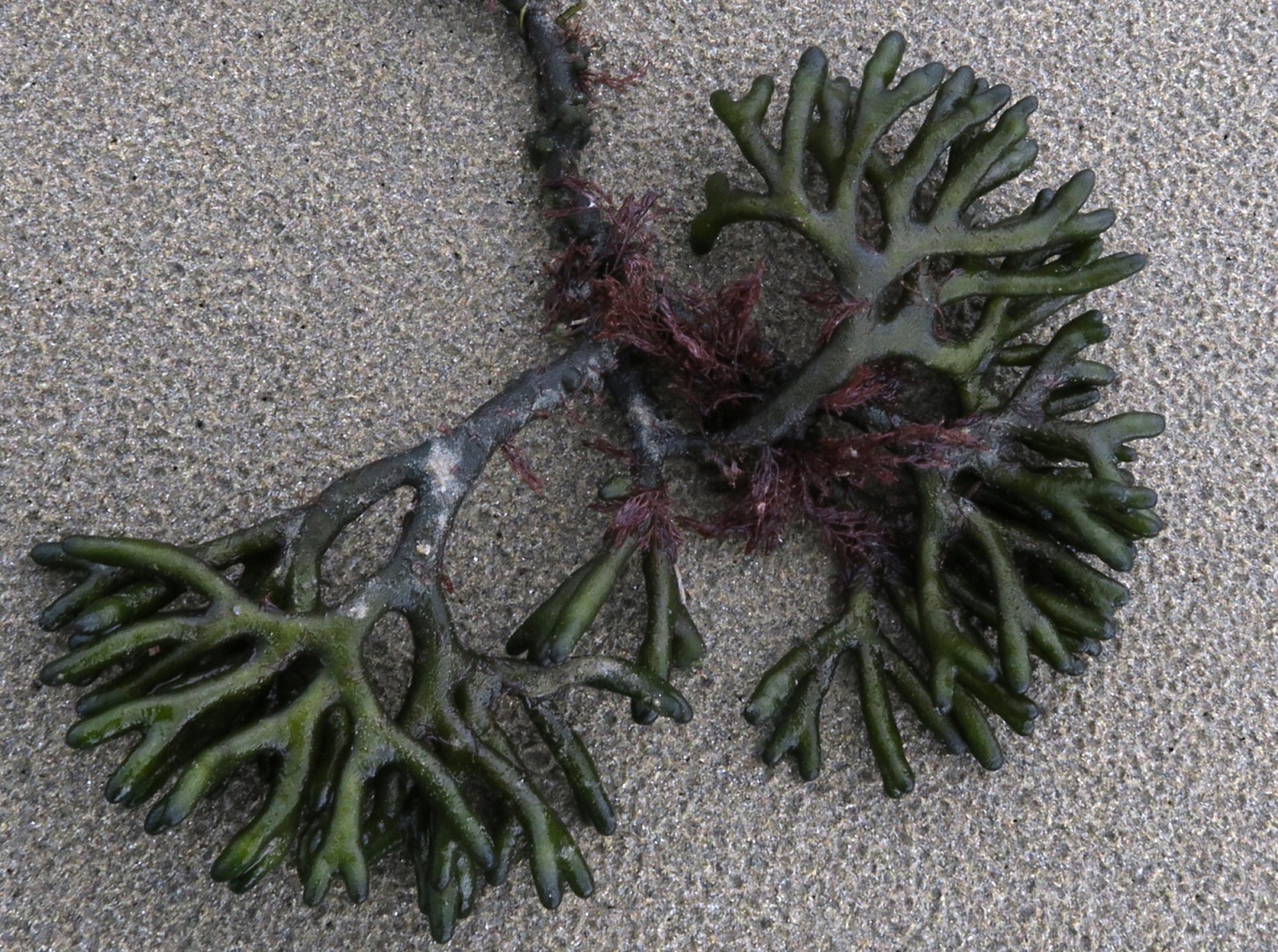
Figure 1: Torn from the substrate and cast ashore by the most recent high tide, this pair of seaweeds is unmistakable – the larger green Codium fragile is hosting the delicately banded epiphytic red Ceramothamnion codicola. Wickaninnish Bay, Vancouver Island, B.C. Canada. May 26, 2025. Photo ID 27798 ©Seaweedwhisperings.com
Person 1:
Tiny and delicate.
Likes its host, wants to be liked / accepted by its host.
Exceptionally perky and vibrant when appreciated.
Likes to be different, and living where it does, epiphytically on Codium fragile, it’s easy to be different; Ceramothamnion codicola’s being contrasts with the simplicity of Codium fragile.
Vivacious. Flamboyant. Spunky.
The pincers (at the branch tips) act playfully…, just nipping, not harmful, just testing.
It’s easy for Staghorn Fringe to be ‘accomplished’ because they don’t have any (or very many) competitors. It therefore can do what it wants and no one is going to interrupt it – except itself.
The banding on the central axes wraps tightly giving structure and regularity.
The ‘regularity’ (banding) is not obvious as one is distracted by the wild overall appearance.
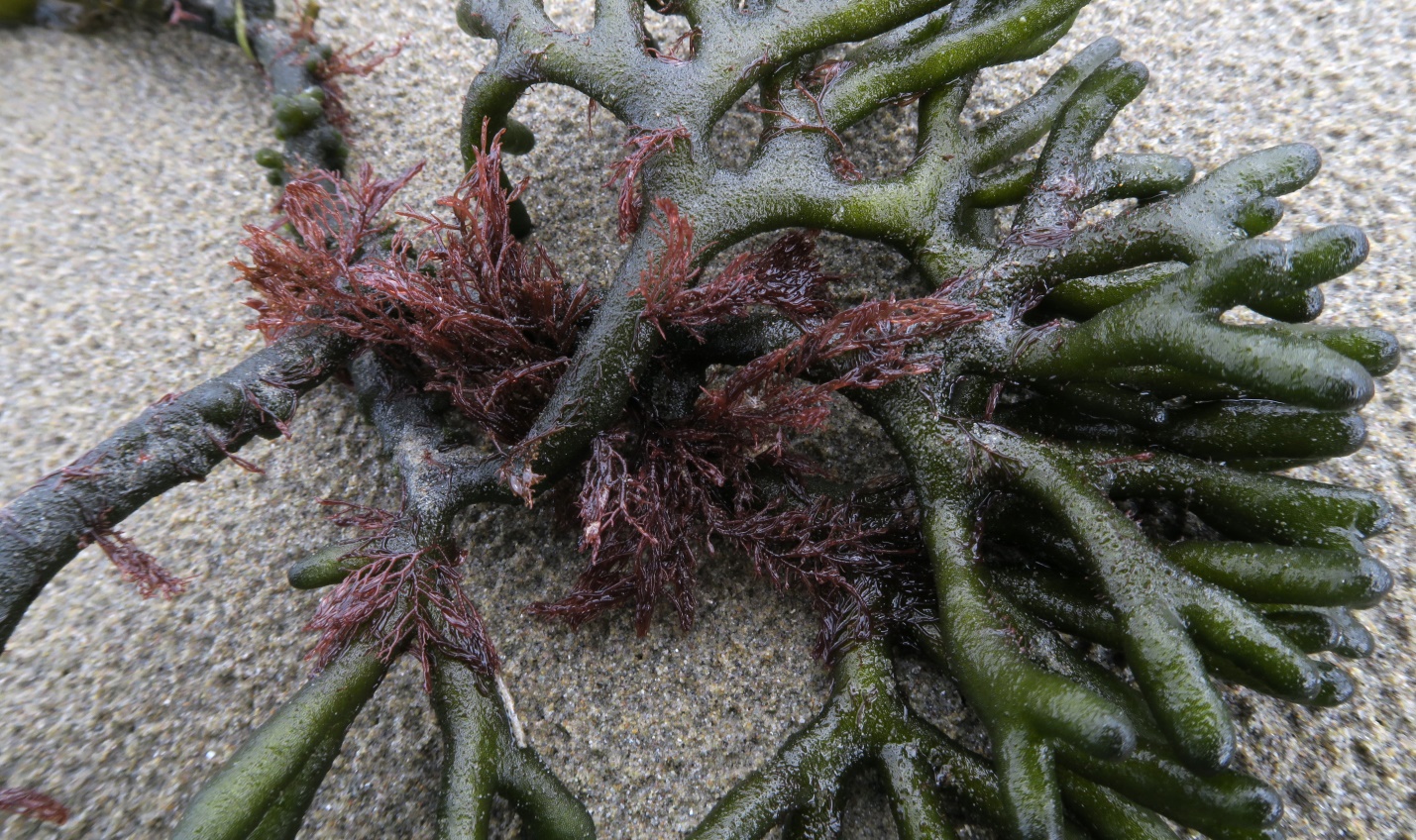
Figure 2: A closer look shows the red alga, Ceramothamnion codicola, seen growing here from the mid sections of the thalli of Codium fragile. The epiphyte penetrates the host with bulbous rhizoids and securely anchors itself in this, it’s exclusive and preferred habitat. Wickaninnish Bay, Vancouver Island, B.C. Canada. May 26, 2025. Photo ID 27799 ©Seaweedwhisperings.com
Person 2:
You are very highly discriminating about where you will live! You grow as an epiphyte only on the green alga, Codium fragile.
How did you come to be so particular? So very specific about suitable living conditions? Pared down to only one option?
Or, have I got it the wrong way around? Are you embarking out as the first Ceramothamnion species to settle new and quite different territory? One who goes out and lives on the stems of Codium fragile!
I wonder if this is exactly your dilemma, Ceramothamnion codicola. When you find something that you like, then quite simply there is nothing better for you. But after a while you grow a bit dissatisfied, perhaps even bored, and so you abandon the familiar and step out in a totally new way. This could really test you in numerous ways, and from the looks of some Ceramonthamnion codicola I see today, life can leave you looking a rather haggard.
“Haggard” is not a word I use often; as such it stood out as I pondered this seaweed a bit more. I sought my dictionary and looked up the word’s etymology. As an adjective this word originated from the French haggard and means “wild, unruly”. Another source provides the origin from Old French faulcon hagard which is “wild falcon” or literally “falcon of the woods”.
Ceramothamnion codicola, by growing on the stems of Codium fragile, actually gives the Codium fragile a “wild and unruly” look – like a man who’s just come back from a long wilderness trek – his beard has grown a bit shaggy and his hair might be rather long and wild looking too. It can look “wild” itself in certain conditions, this red epiphyte, and it grows amongst the ‘forest’ of Codium thalli.
Staghorn Fringe is a smaller species compared to other Ceramothamnion we’ve seen, yet it has the same repeating rings of tiny cells that band its central core with red coloration. This gives you, Ceramothamnion codicola, a texture that is not really perceived by the naked eye, except that you don’t catch the light in one solid line like a smooth filament; the light is interrupted, regularly, reflecting off your thalli differently.
Blinking, winking, on and off..., are you a tease, Ceramothamnion codicola?
Are you inconsistent? Going this way one week and that way the next?
Does your energy blink on and off too? Can it be unreliable and inconsistent, somewhat broken up or patchy?
The branching pattern is mostly dichotomous, and fairly regular. And it branches often; in a 1 cm segment I counted at least 5 dichotomies. Branches are also stiffer than in typical filamentous algae, and their texture is stiffer than their delicate appearance would suggest.
So they like to fork and fork often. Does this allow them to pursue two different roads at the same time…?
Like other members of your genus, you have tiny, tiny forked tips at the ends of your branches. These are like forceps or pincers; they are paired extensions that curve gently towards each other.
Pincers usually are
designed for grasping or gripping things. What would a seaweed do
with so many little pincers? Does something special get produced
between those tiny forcipate tips? Or is it a sensory apparatus?
Could the pincers sample or “take measure” of certain
constituents in the sea water within their range?
Knowing the
incessant “washing away” power of waves it is hard to imagine a
seaweed “holding” or “grasping” much of anything, but maybe
water can be somewhat slowed, stilled and calmed in the tiny isolated
regions between the pincers of Ceramothamnion.
Does this seaweed hold a sample of the sea’s vast entirety, in an
amount and in a manner that promotes communication or understanding?
Is it a kind of sampling or testing? If so, it is one that is
short-lived and assessments must be done quickly; the sea will not
allow itself to be harnessed, even in these clever little branch
tips.
Are you trying to do the impossible? Exploring as you can, but then having to start again as circumstances shift? It seems at times you can realize that your approach may need revision and further adjustments, and sometimes that’s too much to contemplate, so abandonment of goals, seemingly mid-stream, can occur.
Some of the tips of this seaweed that we have found appear to be broken; is this one consequence of being a cast ashore duo (with Codium fragile)? Being cast ashore can involve a harsh landing, including repeated collisions with other flotsam. Were the branch tips we saw today damaged in that way, or are these tiny tips somewhat fragile to begin with?
When I step back again and take the overview of this seaweed I would say that it looks like a red, shaggy fringe. A fringe is ornamental, it’s not functional but decorative; a fringe adds artistic flair to something else that often is functional.
The thing about decorative ornamentation is it is distinctive and often can soon become dated or “out of date” and “out of fashion”. This seaweed has an appreciation for such ornamentation and decoration, and can happily embrace them in the present. Sometimes, though, this look can become a bit hard to maintain, and it will show some real life wear and tear.
Underwater and immersed, I think this Ceramothamnion ornamentation would be even more pronounced – the decoration at times growing a bit out of proportion to the host. This seaweed can often be only 1 or 2 centimeters tall in early season but by late summer it can reach more than double that length. Codium fragile’s own green branch tips, the newest growth, are usually free of the red ‘fringe’, so it is not obliterated by the epiphyte but it certainly has a different look when Ceramothamnion codicola moves in.
I wonder if the host seaweed has an opinion about the presence of this red fringe. I have the sense that the Staghorn Fringe may stir up a fondness in Codium fragile for times past, a type of longing for when they were purely their own green self and not imposed upon in this way.
While the ‘fringe’ may be a bit fragile or tattered at its tips, it never seems to let go at its holdfast – at this level it penetrates the host and aims to stay firmly in place.
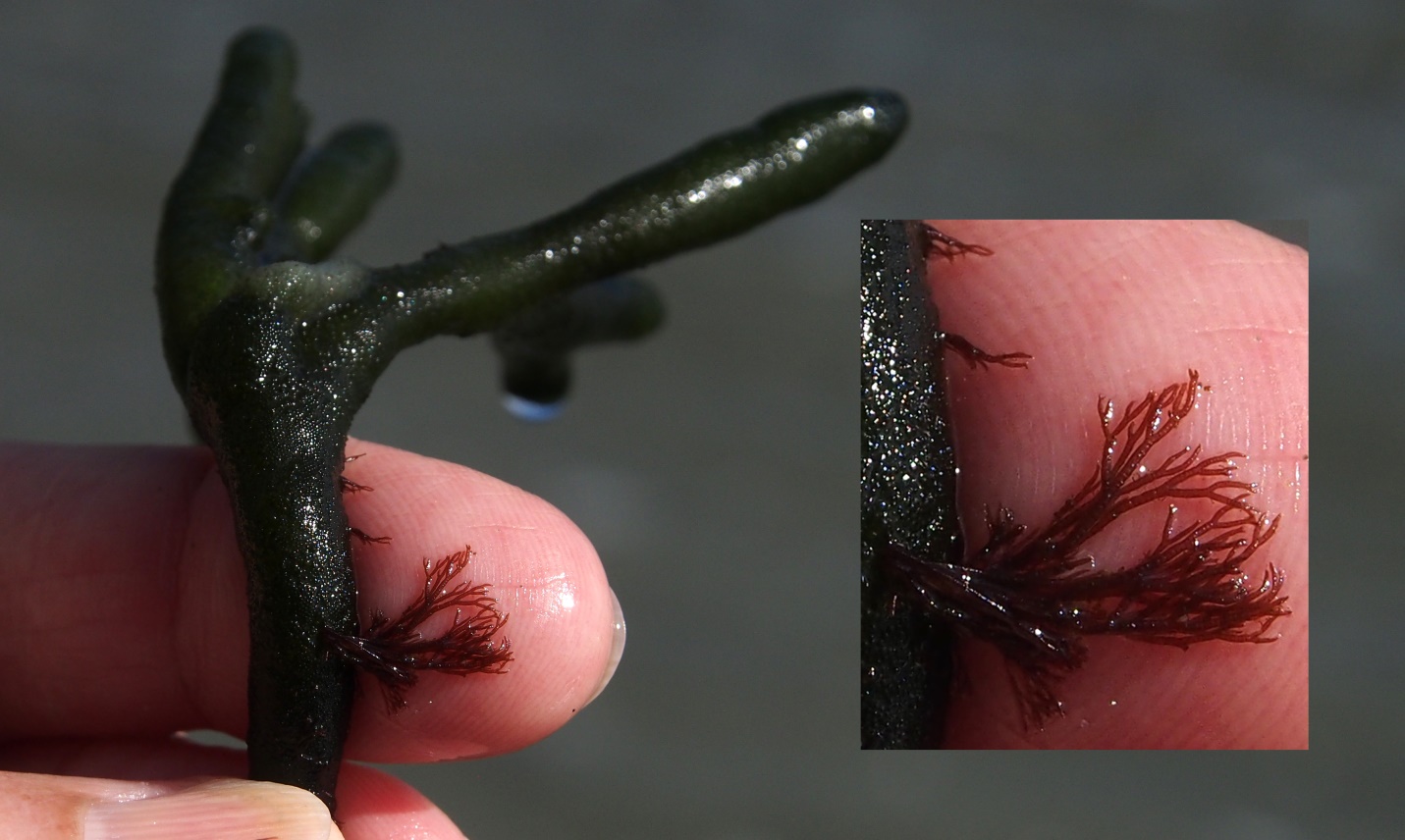
Figure 3: One grouping of Staghorn Fringe is shown here, and magnified to the right. The banding of encircling cortical cells creates a ladder of dots of light along the thalli, and the tiny forcipate tips can be seen on some branches also. Florencia Bay, Vancouver Island, B.C. Canada. May 29, 2025. Photo ID 27800 ©Seaweedwhisperings.com
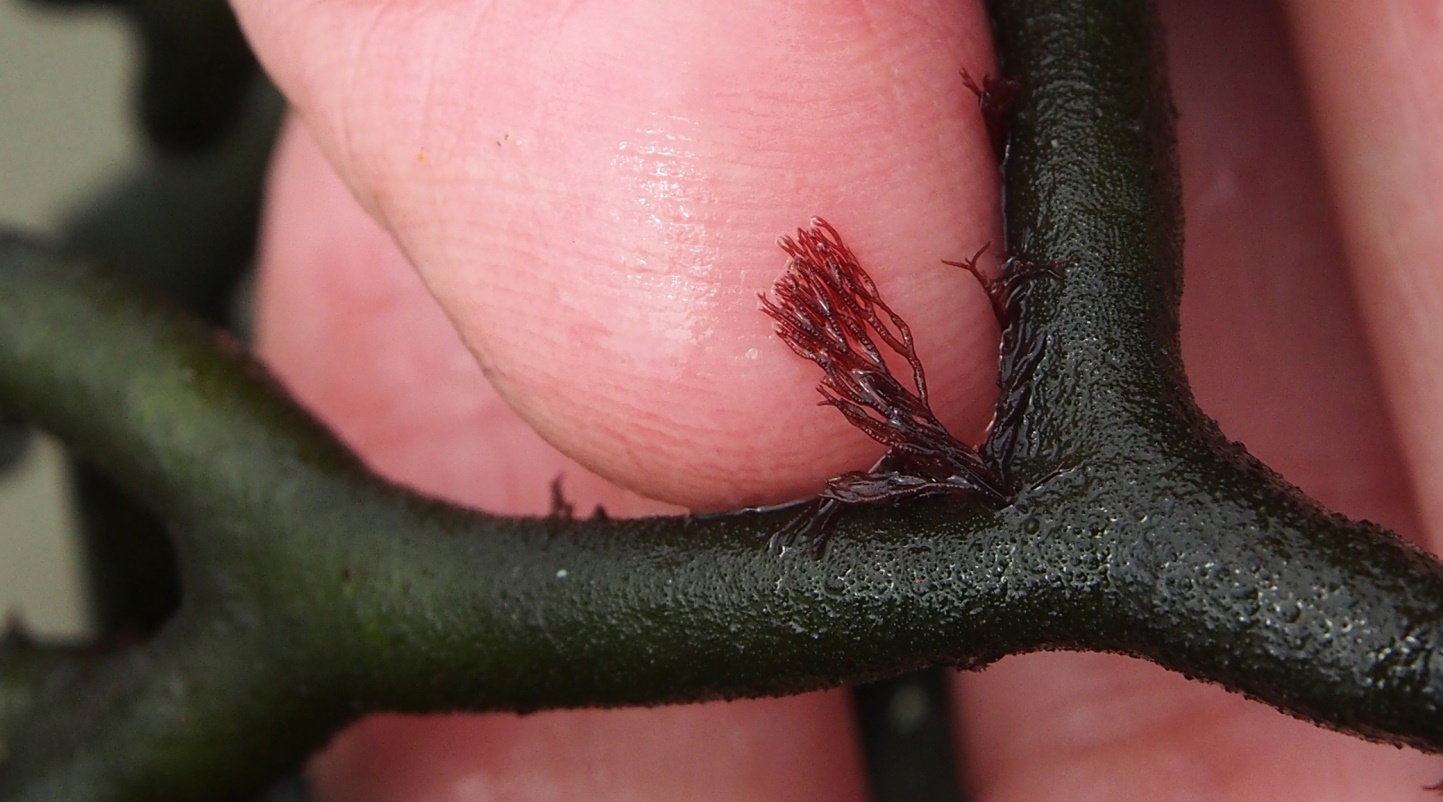
Figure 4: Another example, much larger than life-sized, shows the branching pattern, banded cortical cells (creates a ladder of dots of light along the thalli), and the tiny forcipate tips. This entire cluster is less than 1 cm tall. Wickaninnish Bay, Vancouver Island, B.C. Canada. May 26, 2025. Photo ID 27801 ©Seaweedwhisperings.com
Discussion:
Knows what it thinks it likes, but can get bored. Has a concept of what it likes, and actually holds to that stubbornly for a time, but then becomes dissatisfied and can completely discard it.
Dissatisfaction comes when they are bored. It creates a hunger. The hunger is for a change, a new challenge, some new kind of stimulation.
They can overreach with this appetite of theirs, and then find it is unrealistic to sustain it. Physically, it seems they could be challenged, too; perhaps inconsistently or only intermittently strong.
The branch tips are only gently pinched inwards and this gave the suggestion that perhaps this seaweed is not quite sure what it wants to grasp.
Are they testing or sampling? Yes.
And, why? Because they are quite sensitive and discriminating, and sometimes they’re simply playing.
It’s easy for this seaweed to be ‘accomplished’, Person 1 noted, because it doesn’t have very many competitors. It can do what it wants and no one is going to interrupt it except itself. This is one reason they are so discriminating about their place to live – it gives them the ideal conditions to be accomplished in what they pursue.
They also will be picky about who they associate with. This may be why their pincers are not really grasping tight. They act as sensory input devices to take a “read” on the character of an outsider. Ceramothamnion codicola needs that information, preferably early on, because they are not confident they will do well in new relationships.
If they play or tease, it’s on the bashful side; they like to always be prepared to retreat. It seems that they feel the need to pick and choose with care.
Also we felt clearly that if anyone interrupts Ceramothamnion codicola in their activities or goals, well, it will typically be their own self – not some outsider. They can alternate or blink on and off with their focus and interests.
We considered the regularity of the ‘banding’ all along this seaweed’s thalli. This is a kind of cortication, like bark on a tree, and it gives structure. We felt that the regularity of the banding is a “remnant” of the past. Ceramothamnion codicola doesn’t want to dwell in the past but the past is firmly embedded in its own physicality. And it is this past that gives this seaweed some structural strength; despite that helpful function, there is in their energy a desire to break out of or away from that structure. It is a resistance to having to adhere to the “same old” past ways.
One way they can break away from this “same old” is to create many forks in their branches; this is an attempt to explore two new options simultaneously. However, before long those forks are destined to become banded, corticated, firm and structured, too; so they will need to branch in a fork once again. There is a vulnerable time, too, when the structure is not corticated strongly. It seems Ceramothamnion codicola can try to sample life in ways that are too risky and they either get damaged or quit the effort altogether.

Figure 5: Not such a ‘pretty picture’ this view shows many stems of Codium fragile (large green alga) that have been epiphytized by numerous groupings of Ceramothamnion codicola. It was difficult to tell if these were young starts, or if some of these are broken or damaged thalli of the red Staghorn Fringe seaweed. It is quite possible that both situations are true in this instance. Wickaninnish Bay, Vancouver Island, B.C. Canada. May 26, 2025. Photo ID 27802 ©Seaweedwhisperings.com
Biology & Natural History Information:
Description:
Thalli dull reddish-brown, grows epiphytically on the host green alga, Codium fragile, forming finely branched, delicate, fringing tufts. Length to 1 – 2.5 cm tall, with late summer individuals reaching 5 cm; diameter of thalli is between 150 and 300 microns. Branching is predominantly dichotomous, at times pectinate, with the branch tips usually forcipate. Attaches to host by many bulbous, pigmented, penetrating rhizoids. In this genus, central colorless cells form the core of thalli (all parts) and branches at all orders are corticated in transverse bands of tiny red cells at nodes. This species in particular, C. codicola, is completely corticated except for thin internodal spaces; the banding pattern is still visible but coloration is uniform. This gives it a ‘solid’ dull red color, rather than the ‘clear alternating with red’ banding of other Ceramothamnion species. Along with its specific host preference, this feature aids in certain identification of this tiny red alga in the field.
Habitat:
Common, epiphytic wherever host species, Codium fragile, occurs; low intertidal to shallow subtidal (to 8 meters).
North Pacific Distribution:
Sitka, Alaska to Is. San Benito, Baja California, Mexico, including all major offshore islands.
Remarks:
As far as is known, Ceramothamnion codicola is a strict epiphyte of Codium fragile; other Ceramothamnion species epiphytize a large number of algae and can include Codium.
Classification:
Phylum: Rhodophyta
Subphylum: Eurhodophytina
Class: Florideophyceae
Subclass: Rhodymeniophycidae
Order: Ceramiales
Family: Cermiaceae
Genus: Ceramothamnion
Species: Ceramothamnion codicola (J.Agardh) M.J.Wynne & C.W.Schneider 2023
Former name(s): Ceramium codicola J.Agardh
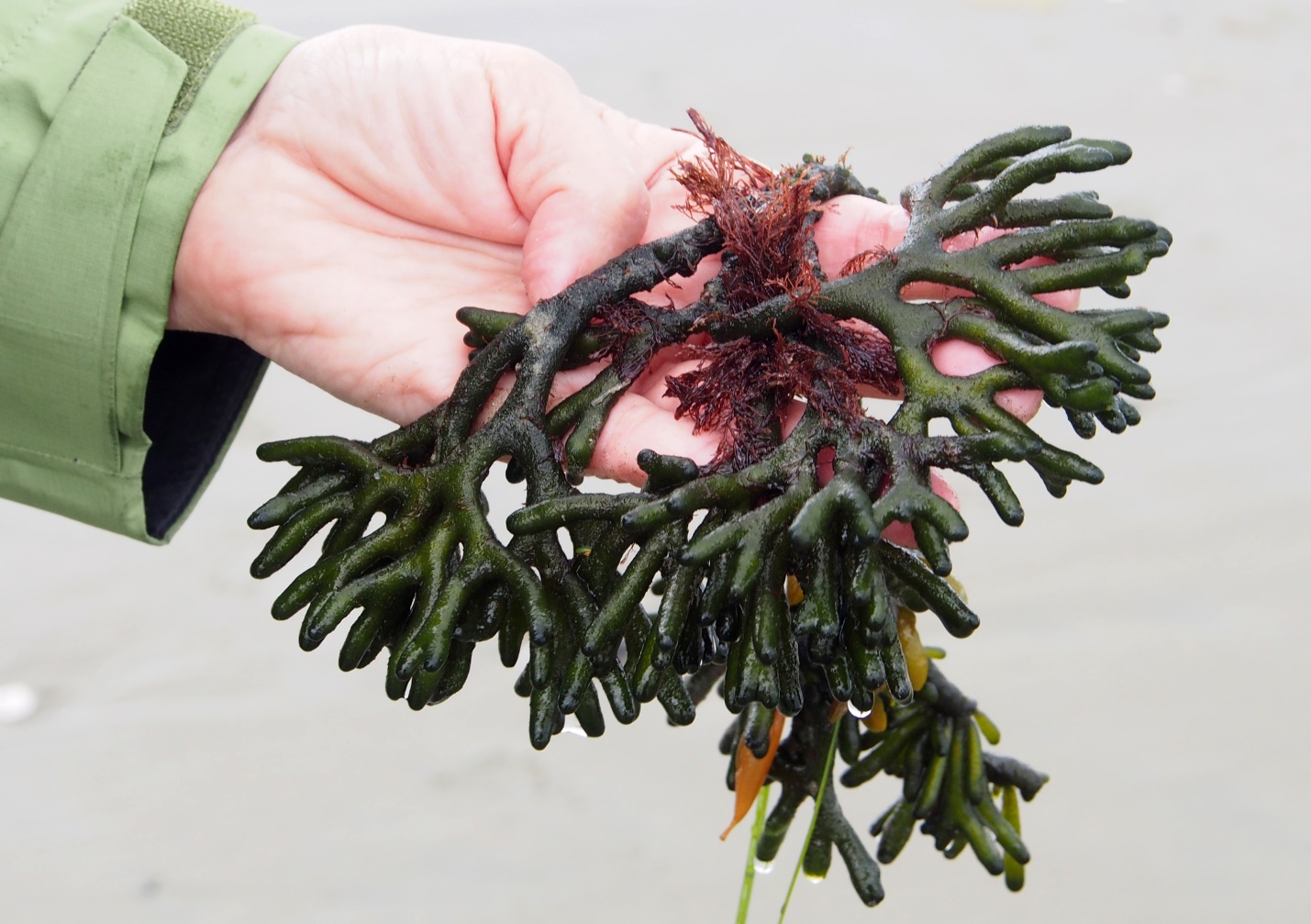
Figure 5: In hand, the relative sizes of the two seaweeds are evident. Just what conditions tore the Codium fragile from its holdfast are impossible to know, but on this day we found many such examples. Wickaninnish Bay, Vancouver Island, B.C. Canada. May 26, 2025. Photo ID 27803 ©Seaweedwhisperings.com
![]()